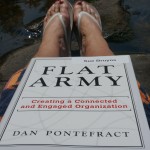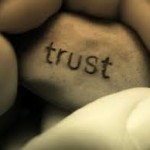For the past few years, each June, administrators in our board have been given a professional resource (or two) to enjoy over the summer. The two most recent books were Stratosphere by Fullan and Intentional Interruption by Katz. I found both resources to be informative and impactful on my work within my new portfolio. In fact I shared my thoughts on them in past posts on this blog.
So this June, when Flat Army was placed on my desk, for my summer reading pleasure, I anxiously awaited for my alone time at the cottage and quickly found a quiet spot away from the bustle of the fishing expeditions, the concentration of the jigsaw completion and the aimless raft floating. Within the first few lines, my pen was poised and I was filling the margin with asterisks, question marks, and personal connections. I was emphatically underlining quotes and comments which resonated with me.
Pontefract effectively paints a picture of an organization where ideas flow seamlessly throughout the ranks paying no heed to position, paycheck or past experience. He challenges our status quo notion of the best and brightest ideas being brought forward by those in the greatest power positions. Instead of a system based on hierarchy, he poses the challenge of a “Wirearchy ~ a dynamic two way flow of power and authority based on knowledge, trust, credibility and a focus on results enabled by interconnected people and technology”.
Within that list of criteria, which is most important to you? For me, the concept of trust is significant. As a leader I want those whom I have the opportunity to work with to know that I trust them. I trust them to do their job, to be responsible to themselves and to those they work with. I trust them to extend their own learning and to bring new ideas forward. When they do, we’ll try them. If they work, Great, if not ~ what did we learn for the next time?
A skill that I have learned is to always question myself about my intention versus what others eventually see as my actions. Trusting my team is my intention, but does it come across with my actions? I guess I better find out!
Unfortunately, not all employees feel trusted. Pontefract shares, “We’ve learned to become helpless. We’ve become numb to our bosses who don’t care. We’re ambivalent to leadership that is hierarchical and closed minded. We’ve become blind to exclusivity and too paralysed to suggest being included.”
It is sad to think how many innovative, exciting, trendsetting ideas sat dormant, because someone was “too paralyzed” to share.
“Social media flattens hierarchy” is not a quote from the book, but a connected idea that was shared at an Edcamp a few weeks ago. How true!! Today, anyone has access to the thoughts, ideas and newest research from the greatest minds all over the world. With the quick swipe of a finger or a click of a mouse and the ability to critically analyze the validity of that information, we can process and implement what we read immediately. And just as our teachers need to come to grips with the fact that they are no longer the “only imparter of knowledge”, leaders need to appreciate that the next best idea may come from an employee who has read a book, read a Tweet, read a blog or had a deep discussion with another. In order for that employee to feel comfortable sharing that idea, the culture must be created for that to happen without any repercussions (real or perceived). No more admonishments for not following the hierarchical procedure of asking questions or sharing information. No more threats of being sent to a less desirable department/school location. No more closed communication communities. Information should flow seamlessly throughout an organization.
Open source, open doors, open minds and open hearts will lead to an innovative, healthy organization.
No longer can we expect our leaders to be on the “cutting edge” of every new technology, new leadership concept or the latest trending idea, as information is coming at all of us at a tremendous speed and volume. But we should be able to expect that they are there, right alongside of us, learning. Trying new technologies, seeking feedback on their ideas and thoughts in online social forums, sharing their own learning challenges and successes.
Isn’t that what we want for today’s learners? All learners ~ students, educators and those leading educational organizations.
Today’s leaders need to be engaged in “Social Learning ~ serendipitous learning that happens through social exchanges that results in a knowledge negotiation”. And those social exchanges should be happening with people at all levels of the organization and worldwide via the Interent. I would be concerned if leaders only spent time with each other ~ only learning from each other. Pontefract shares pictures and stories of Mayor Bloomberg out and about within the office. Sitting with others ~ not holding “court” in his office.
As leaders, how often do we immerse ourselves in the very work that we are leading? Do we leave it to others to present the final product to us or do we roll up our sleeves and experience it first hand? Experience true learning complete with the frustrations and the excitement?
I wonder if we created a more connected and engaged organization where our leaders didn’t feel the burden of having to always be the “one” with the answer, would that allow them more time in the field where they, too, could be learning?
Needless to say, this latest resource did not disappoint! I was thankful that I had applied a layer of sunscreen that day, as my “I’ll only be a few minutes”, turned into an uninterrupted reading of Flat Army cover to cover ~ margins filled, highlights throughout and more questions than answers. And here I am, weeks later, questions still resonating, tweets with the hashtag “flatarmy” still being posted and looking forward to chatting with other colleagues who have read the resource.
There were many take away quotes from this book. But for the purpose of this post, the one I will leave my readers with is this one, “I will practice caring, sharing and daring ~ caring for others, sharing what I know and daring to try new things”
As a leader, do you consider yourself connected and open to the ideas of others? Would others consider you connected and open to their ideas?
Come write with me…..



